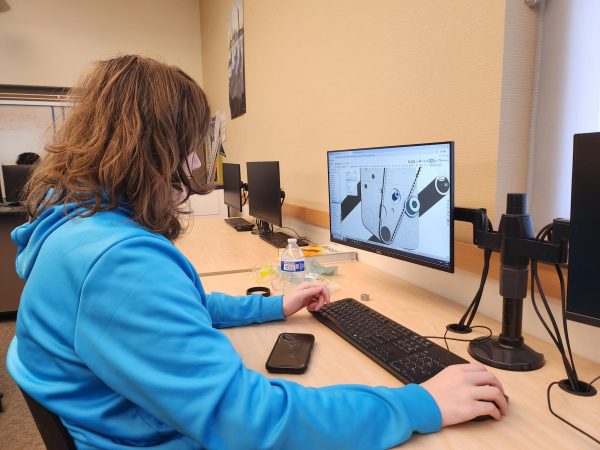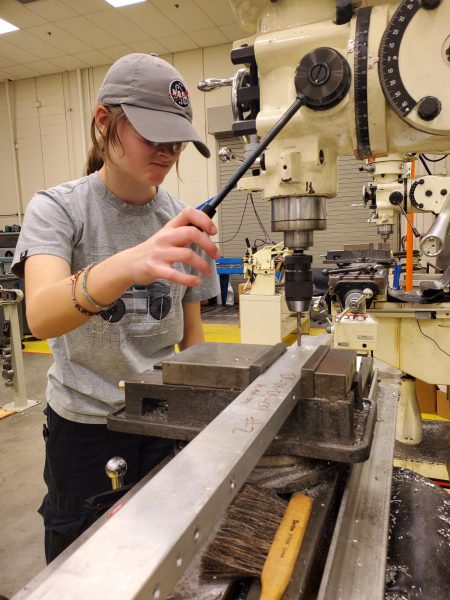The start of the new year means new resolutions and new goals. For the Liberty FIRST Robotics Competition (FRC) team, also known as the Iron Patriots, it means the beginning of build season to create a new robot for spring competition.
On the first Saturday of the year, in January, the organization For Inspiration and Recognition of Science and Technology (FIRST), which holds robotics competitions internationally for high schoolers, releases the new game for the year. The game is based on a STEM-related theme. After the game’s release, the Iron Patriots have eight weeks before the first competition in March to make a fully functional robot.
This year’s game theme is Crescendo, which is music related. The robot will need to be able to throw “notes”, the themed term for rings, into amps and speakers, the names for different-sized containers, and climb onto a hanging chain called the stage, to earn points.
There are several subteams that work on different parts of the robot: Design, Hardware, Electronics, and Software. These teams all work together to produce a robot in preparation for competition.
Photo by Katarzyna Nguyen– Working through it: Design head Ryder Klein (10) works on a design for the sideplate for the outtake layer that will shoot rings out into the containers.
Design:
Sophomore Ryder Klein only joined the Iron Patriots last year as a freshman. Now, he is the head of the Design subteam, which works to design the robot to fit the parameters of the competition and create a blueprint for the other subteams to use. For Klein, being in a leadership role this year for build season means some major changes have been made.
“Last year, we had a senior that was the Design head. While there were some tasks shared with other people, he basically did everything,” Klein said. “This year, we’re able to get multiple people designing, allowing us to spread our work out more evenly, so things go much quicker, and we get more diverse input.”
Although plans change constantly during build season as they figure out what designs work best, right now, the Design subteam plans to take the rings from under the robot and then shoot them out.
“If it looks like it can be made cheaply, then we’ll just make it and see how it works,” Klein said. “If it seems more expensive to make, one that’s more likely to be the final product, we make a rougher creation, usually out of wood or another material. That way, we get a vision of how it’d look and work. Eventually we’ll iterate through that, adjust certain features and come up with the final product.”
Klein is determined to lead his subteam to make this year’s design for the robot the best they’ve had so far, but he’s also committed to their future.
“I’m hoping that I’ll be able to build up a sustaining subteam that will last even when I eventually graduate,” Klein said.
Photo by Rei Gilbert– Drilling holes: Hardware co-head Kambree Taylor (10) creates a part of the drive base for the robot.
Hardware:
Sophomores Rei Gilbert and Kambree Taylor are the heads of the Hardware subteam, specifically the manufacturing and assembly groups, respectively. Their subteam works to prototype, manufacture and assemble parts of the robot.
Max Kincaid is a freshman who just joined this year as part of Hardware.
“I heard about Robotics from my sibling, and I’ve always liked building, so I thought joining the Hardware team specifically would be a fun way to do that,” Kincaid said. “So far, we’ve just been brainstorming ideas and once we have things that work, we prototype. When we find something that we like and works well, we make it.”
At the moment, their plans are to have two layers of wheels where one spins inwards to suck the ring into the robot and the other layer spins outwards to shoot the ring out of the robot and into the container.
“We had something similar to that last year with our claw mechanism to pick up cones and cubes, but this year, it’s more like a sandwich of the wheels so the ring can fit inside,” Gilbert said.
Electronics:
After the construction of the robot is finished, the Electronics subteam, led by senior Victor Wang, creates a control system of wires and components that will eventually be used to make the robot perform the functions it needs to win the game.
“We design, fabricate, and maintain the control system, which is a system of components that are wired together and modified in a way so that Software can interface their code to make the actual hardware systems perform the way that Design wants them to,” Wang said.
Photo by Katarzyna Nguyen– Hooking it up: Electronics head Victor Wang (12) cuts a wire while Connor Poehlman-Kaufman (9) assists him.
While the wiring itself stays the same, each year’s game affects what electronic components are emphasized.
“Last year, since it was a grab-and-go game, we wanted to optimize mobility and speed. For wiring, that meant we used motors with high torque gearing so that robots could accelerate faster,” Wang said. “This year, it’s a shooter game, so we’re trying to make a robot that can intake as many rings as possible in a short period of time. We’re using a lot more sensors, cameras, and brakes, so the robot knows where rings are on the field.”
Software:
The Software subteam, led by junior Scarlett Saam, works to code the robot so that it knows where to move and what to do during competition.
“Last year, we didn’t have a lot of time to do the coding, there was a lacking of comments on the code to point out what was actually happening. It lacked some order and simplicity,” Saam said.
In the game, there are two sections for the robot to complete: autonomous, where the robot goes on its own, and tele-op, in which the robot is controlled with video game controllers by the drivers, which are people.
“We’re going to try to have some built-in functions when they’re doing the tele-op. That is, you could press a button, and then it does something autonomously, which will make it simpler for the drivers and hopefully let us score more points,” Saam said.
Due to limited time last year to work on coding and teach it, as this year’s Software head, Saam is also making an effort to teach coding to both new members and returners.
“This year, we’re trying to do as much as we can without the robot. We have the drive base from last year’s robot that we can put code onto and practice on while everybody’s designing and wiring and trying to make the new robot,” Saam said.






